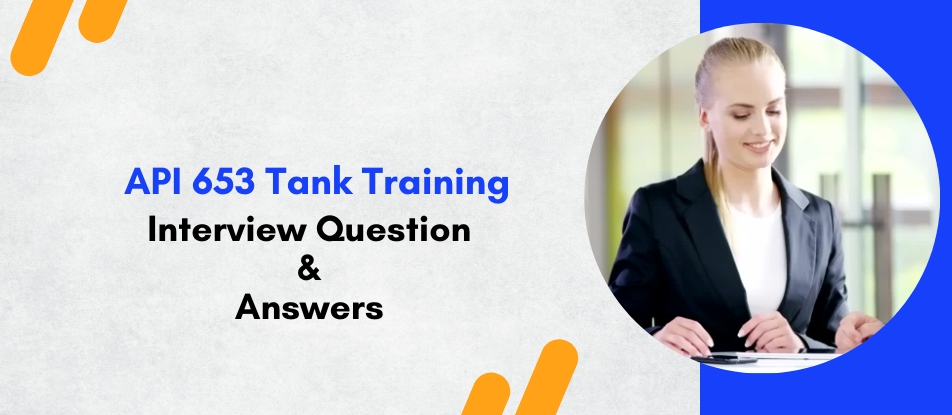
The API 653 Tank Training course equips professionals with the skills to inspect, maintain, and repair aboveground storage tanks in accordance with API 653 standards. Participants learn about tank design, corrosion evaluation, NDE techniques, welding practices, and regulatory compliance. Ideal for engineers, inspectors, and maintenance personnel, this course ensures safe tank operation, effective failure prevention, and extended service life of tanks in oil, gas, and chemical industries.
API 653 Tank Training Interview Questions Answers - For Intermediate
1. What are the API 653 requirements for welding repairs?
API 653 requires all welding repairs to follow approved procedures that are qualified as per ASME Section IX. Welders must be certified, and post-weld inspections like visual and NDE are mandatory to ensure the integrity of the repair.
2. What is a shell-to-bottom weld and why is it critical in tank inspection?
The shell-to-bottom weld connects the vertical tank wall to the bottom plate. It is a high-stress area vulnerable to corrosion and leaks, making it a key focus during both external and internal inspections under API 653.
3. How is a tank floor scan conducted, and what does it detect?
A tank floor scan uses techniques like Magnetic Flux Leakage (MFL) to detect pitting, corrosion, or metal loss. It’s especially useful when a tank is taken out of service and helps prioritize repairs or floor replacement.
4. What is the significance of the critical zone in tank inspection?
The critical zone is the area within 3 inches above and 3 inches below the shell-to-bottom weld. Due to its exposure to product, water, and environmental conditions, it’s prone to corrosion and must be closely monitored.
5. When is it acceptable to use lap patches in tank repairs?
Lap patches are used for temporary repairs or when permitted by engineering judgment and standards. API 653 allows them under specific conditions, like limited corrosion depth and non-critical service tanks, and requires proper weld sealing and testing.
6. How does API 653 define tank reconstruction versus repair?
Repair involves replacing or fixing specific components without altering the tank’s basic configuration. Reconstruction involves major changes, such as relocating, resizing, or rebuilding parts of the tank, often requiring requalification and hydrostatic testing.
7. What documents and standards should be reviewed before beginning an API 653 inspection?
Inspectors should review the tank’s original design documents, previous inspection reports, repair history, calibration certificates for inspection equipment, API 653 standards, and any applicable environmental and safety regulations.
8. What is the minimum required shell thickness for continued service?
The minimum required shell thickness is based on internal pressure, corrosion allowance, and calculated stress. API 653 provides formulas to determine this, ensuring that the shell maintains sufficient strength for safe operation.
9. What is the purpose of settlement survey data in API 653 compliance?
Settlement surveys monitor the tank’s foundation behavior. Uneven or excessive settlement can compromise the tank’s structural stability, leading to cracks or leaks. API 653 outlines how to measure and evaluate settlement tolerance.
10. How do you determine the Remaining Life of a tank?
Remaining Life = (Measured Thickness - Minimum Required Thickness) / Corrosion Rate. This estimate helps plan the next inspection or maintenance, ensuring proactive risk management.
11. What safety precautions are needed during an API 653 internal inspection?
Before entry, the tank must be gas-freed, ventilated, and tested for oxygen and hazardous gases. Confined space entry permits, PPE, and rescue plans are essential to protect inspection personnel.
12. What are common causes of external corrosion on aboveground storage tanks?
External corrosion can be caused by environmental exposure (humidity, rain, salt), poor coatings, soil contact, and inadequate drainage. Regular coating maintenance and cathodic protection help mitigate this risk.
13. How are nozzles inspected under API 653 guidelines?
Nozzles are inspected for corrosion, cracking, misalignment, and weld defects. Thickness checks and NDE are performed around the nozzle neck and attachment welds to ensure safe operation and prevent leaks.
14. How do environmental regulations impact API 653 inspections?
Inspectors must consider local environmental laws related to emissions, spill prevention, and waste disposal. Compliance with EPA, OSHA, and other authorities may affect tank repair methods and inspection intervals.
15. What is a tank out-of-plane distortion and how is it measured?
Out-of-plane distortion is a bulge or dent in the tank shell, usually due to overpressure or settlement. It’s measured using laser scanning or profile gauges and must be assessed against allowable limits in API 653.
API 653 Tank Training Interview Questions Answers - For Advanced
1. How are annular plates evaluated during API 653 inspections, and what are their functions?
Annular plates are thicker steel plates installed around the perimeter of the tank bottom, directly under the shell. Their main function is to reinforce the critical shell-to-bottom joint area, which is subject to higher loads and stress concentrations. During inspections, these plates are evaluated for corrosion, weld defects, and settlement issues. Ultrasonic thickness testing is conducted across the plate area, especially near the shell welds. If the annular plate shows severe corrosion or damage beyond acceptable limits, it may need to be replaced. API 653 sets minimum thickness and size requirements for annular plates, especially when tank bottoms are reconstructed. The presence and integrity of annular plates significantly affect the structural performance and leak resistance of tanks.
2. What is the role of cathodic protection in maintaining tank floor integrity, and how is it inspected?
Cathodic protection (CP) is a corrosion prevention technique used to protect tank floors from corrosion, especially when they are in contact with moist soil or concrete pads. API 653 encourages the use of CP systems, particularly for double-bottom tanks. The effectiveness of CP is evaluated using potential readings measured with reference electrodes. These readings are compared to standard thresholds (e.g., -850 mV with respect to a copper/copper sulfate electrode). If the readings are below the required level, it indicates the system is not providing sufficient protection. Regular monitoring, along with proper design and maintenance of CP systems, extends the life of the tank floor and delays the need for costly repairs.
3. What are the API 653 guidelines on nozzle alterations and reinforcements?
Nozzle alterations, such as increasing the size, adding new nozzles, or changing the service type, are treated as alterations under API 653 and must be carefully evaluated to maintain tank integrity. The standard requires calculating reinforcement areas around the nozzle to ensure the structural stability of the tank shell. This includes replacing lost metal from the opening with reinforcing pads or repads that distribute stresses. Welds must follow ASME IX procedures, and the altered area must undergo appropriate NDE. Post-repair inspection and pressure testing may also be required based on the service and material involved. API 653 ensures nozzle alterations do not compromise the shell's structural strength or cause leakage under pressure or thermal stress.
4. How are elevated tanks or tanks on supports handled differently during API 653 inspections?
Elevated tanks, such as those mounted on legs, saddles, or ring walls, introduce unique inspection challenges. Inspectors must evaluate the condition of the supports for corrosion, cracking, misalignment, or signs of overstress. The interface between the tank bottom and the support can be susceptible to hidden corrosion due to water pooling or insulation. Settlement or shifting of the support base must be measured and compared to allowable tolerances. In some cases, additional structural analysis is needed to confirm continued suitability-for-service. Vibration and wind loading are also factored into the inspection of elevated tanks. Any damage or deterioration in the support structure can critically affect tank safety.
5. What are the API 653 criteria for calculating minimum shell thickness using corrosion rates?
To determine the minimum required shell thickness, API 653 provides a formula incorporating internal design pressure, diameter, material allowable stress, and corrosion allowance. Inspectors calculate the current corrosion rate using historical thickness measurements, then project it over the inspection interval. The formula also considers the joint efficiency and tank height. If the actual shell thickness is below the calculated minimum (after accounting for corrosion), the tank is deemed unsuitable for continued service unless repaired. This proactive method prevents failures due to wall thinning and allows for planned repairs or de-rating of the tank's capacity.
6. What documentation is mandatory when performing major tank repairs per API 653?
API 653 requires comprehensive documentation for all major repairs. This includes an inspection plan, welding procedure specifications (WPS), welder qualification records (WQR), NDE results, inspection checklists, and repair logs. A record of material certificates, replacement part specifications, and calculations (like MAWP and corrosion rates) must also be maintained. Upon completion, a Repair/Alteration Report form (commonly the API 653 Form A or B) is signed off by the inspector. All documentation must be traceable and stored for future reference or audits. This ensures accountability and compliance with safety and regulatory requirements.
7. How are edge settlement and center settlement different, and how are they measured in API 653 inspections?
Edge settlement occurs when the tank perimeter settles more than the center, often due to poor foundation drainage, while center settlement is the opposite. Edge settlement can cause the shell to buckle outward, and center settlement may lead to cracking or floor plate distortion. API 653 outlines methods such as optical leveling or laser scanning to measure these deformations. It provides criteria for acceptable limits of out-of-plane distortion. If the settlement exceeds tolerances, corrective action such as jacking or foundation stabilization may be needed. Left unaddressed, differential settlement can severely compromise tank integrity and sealing.
8. Describe the API 653 procedure for evaluating floating roof tanks.
Floating roof tanks require inspection of both the roof and associated sealing mechanisms. Inspectors evaluate the pontoon or double-deck structure for leaks, corrosion, and deformation. The rim seal system is checked for alignment, wear, and vapour loss control. Roof drains, support legs, and rolling ladders are also reviewed for operability. API 653 emphasizes inspection of welds, pontoons, and primary/secondary seal integrity. Defects like leaking pontoons may require roof removal and repair. These tanks are particularly susceptible to weather effects and operational movement, so regular inspection ensures environmental compliance and safe operation.
9. What inspection methods are used for weld overlays and why are they necessary?
Weld overlays are used to restore corroded surfaces, often on the tank floor or shell. The overlay adds a corrosion-resistant layer of weld metal on top of the base metal. Inspection includes visual testing (VT), dye penetrant testing (PT) for surface cracks, and ultrasonic testing (UT) for thickness verification. Overlay procedures must meet ASME IX, and hardness testing may also be required to ensure compatibility. API 653 allows overlays as a valid repair method, provided they meet thickness, bonding, and structural criteria.
10. What is the purpose of the hydrostatic uplift check in tanks with double bottoms?
For tanks with double bottoms or new floor additions, API 653 mandates a hydrostatic uplift check to ensure that groundwater pressure beneath the tank cannot lift the floor. This involves comparing the downward weight of the tank contents with the upward hydrostatic pressure from groundwater. If uplift is possible, a proper drainage layer, venting, or anchoring system is required. Failure to account for uplift can result in tank displacement or cracking of the new bottom, leading to leaks and costly repairs. The uplift analysis is a critical component in tank retrofits and reconstructions.
11. How is a shell distortion analysis conducted under API 653?
Shell distortion is measured using circumferential and vertical roundness checks, often with lasers, plumb bobs, or total stations. The distortion may result from internal pressure, settlement, wind loads, or impact. API 653 provides guidelines for allowable shell out-of-roundness depending on tank diameter and design. Excessive distortion may lead to seal failure in floating roofs or cause internal stress concentrations. If distortion exceeds limits, the tank may need to be jacked and reshaped, or the affected shell section replaced. Advanced analysis may involve finite element methods for stress distribution assessment.
12. What are the challenges in inspecting tanks with linings or coatings on the interior surfaces?
Internal linings and coatings can mask corrosion or defects, making visual inspection challenging. If the coating is intact, only limited NDE like UT may be possible. If blisters, delamination, or discoloration are observed, sections may need to be stripped to inspect the base metal. Linings must also be inspected for chemical compatibility, adhesion, and integrity. API 653 allows lined tanks but stresses careful evaluation, particularly when storing aggressive chemicals. Poorly maintained linings can give a false sense of security and delay necessary repairs.
13. How are tank shell penetrations like manways and cleanouts evaluated in API 653 inspections?
Penetrations such as manways, cleanouts, and nozzles are inspected for corrosion, weld defects, and deformation. These areas are stress concentrators and prone to leaks if not maintained. API 653 requires checking reinforcement calculations, especially if alterations were made. Sealing gaskets, flange faces, and bolting are also inspected. If the penetration has experienced internal pressure or temperature cycling, it may be more susceptible to cracking or fatigue failure. Repairs must maintain original reinforcement area and use code-compliant welding and inspection procedures.
14. Describe the process for creating an Inspection and Maintenance Plan (IMP) under API 653.
An IMP outlines a tank's long-term strategy for inspections, repairs, monitoring, and regulatory compliance. It starts with a risk assessment—based on tank age, contents, corrosion history, and design—followed by setting inspection intervals and choosing inspection methods. The plan includes routine tasks like external inspections, settlement checks, and CP monitoring, as well as major inspections like internal UT and MFL scanning. It also defines roles, documentation procedures, and triggers for FFS assessments. A good IMP supports asset management, safety, and regulatory reporting while reducing unplanned downtime.
15. What role does the authorized API 653 inspector play in ensuring tank safety and compliance?
The authorized API 653 inspector is responsible for evaluating tanks for compliance with API 653 and related standards. Their duties include developing inspection plans, performing inspections, interpreting NDE results, approving repairs, and validating documentation. The inspector must possess deep knowledge of tank construction, degradation mechanisms, repair procedures, and regulatory requirements. Their judgment is critical when determining whether a tank is fit for service or needs to be taken out of operation. In many jurisdictions, inspectors also liaise with regulators, third-party engineers, and stakeholders to ensure safe operation, legal compliance, and environmental protection.
Course Schedule
| Dec, 2025 | Weekdays | Mon-Fri | Enquire Now |
| Weekend | Sat-Sun | Enquire Now | |
| Jan, 2026 | Weekdays | Mon-Fri | Enquire Now |
| Weekend | Sat-Sun | Enquire Now |
Related Courses
Related Articles
Related Interview
Related FAQ's
- Instructor-led Live Online Interactive Training
- Project Based Customized Learning
- Fast Track Training Program
- Self-paced learning
- In one-on-one training, you have the flexibility to choose the days, timings, and duration according to your preferences.
- We create a personalized training calendar based on your chosen schedule.
- Complete Live Online Interactive Training of the Course
- After Training Recorded Videos
- Session-wise Learning Material and notes for lifetime
- Practical & Assignments exercises
- Global Course Completion Certificate
- 24x7 after Training Support

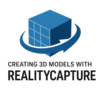
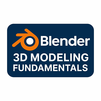




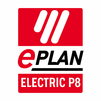
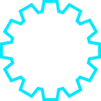
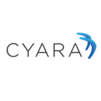
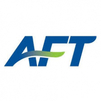
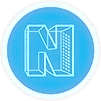


 Join our Live Instructor-Led online classes delivered by industry experts
Join our Live Instructor-Led online classes delivered by industry experts